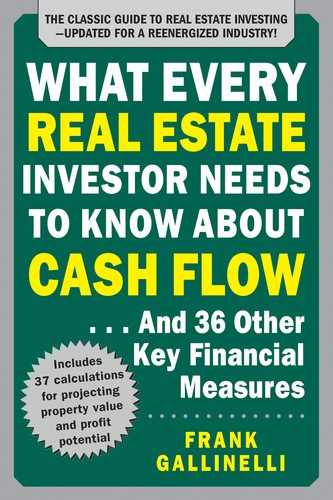CHAPTER 11
Calculation 5: Gross Rent Multiplier
What It Means
The gross rent multiplier (GRM) is a simple method by which you can estimate the market value of an income property. The GRM is a market-driven measurement. You presume that, if buyers have recently been paying X times the gross income for properties in a certain location, then the market value of a property you are considering for purchase should work out to that same “X times” its gross income.
The advantage of the GRM is that it is so easy to calculate. You don’t need a computer; you probably don’t even need the back of an envelope, but rather can do the math in your head. The disadvantage is that nothing so basic is likely to be extraordinarily accurate or reliable. GRM ignores the time value of money, and it makes no differentiation between properties where tenants may pay all, some, or none of the operating expenses.
This measurement can serve as a useful precursor to a serious property analysis, however. For example, if you see that a property is offered for sale at a GRM significantly higher than what is typical in the market, you can expect that a detailed analysis is probably not going to make this investment look more appealing, except at a substantially lower price. You can then decide if you want to spend the time doing research and making projections in a case where the GRM warns you that the property is probably greatly overpriced.
How to Calculate
Gross Rent Multiplier = Market Value / Gross Scheduled Income (annual)
By transposing this equation, you also get:
Market Value = Gross Rent Multiplier × Gross Scheduled Income (annual)
Example
You find that five apartment buildings have sold in the past six months on the upper West Side of town. The sales data are shown below:

The math is straightforward. For each property, you divide the selling price by the gross income to determine its GRM.

Test Your Understanding
1. What is the average GRM indicated by the preceding sales in the example?
2. If you are considering the purchase of a similar property, also on the upper West Side and with a gross rent of $150,000, what would be that property’s value, as indicated by the neighborhood’s average GRM? Round the answer to the nearest $5,000.
3. What range of possible values would these prior sales suggest? Again, round the answer to the nearest $5,000.
Answer
1. The average GRM for the area would equal the sum of the GRMs divided by 5.
(7.010 + 6.800 + 7.422 + 6.093 + 6.957) / 5 = 34.282 / 5 = 6.8564
2. To find the value indicated by the average GRM, you multiply the gross rent by the GRM.
150,000 × 6.8564 = $1,028,460, or $1,030,000 (rounded)
3. To find the range of value indicated by the GRMs in the sample, multiply the gross rent by the smallest and by the largest GRM in the sample.
150,000 × 6.093 = $913,950
150,000 × 7.422 = $1,113,300
The GRMs of the sales in the area suggest a range of values between $915,000 and $1,110,000 after rounding.
